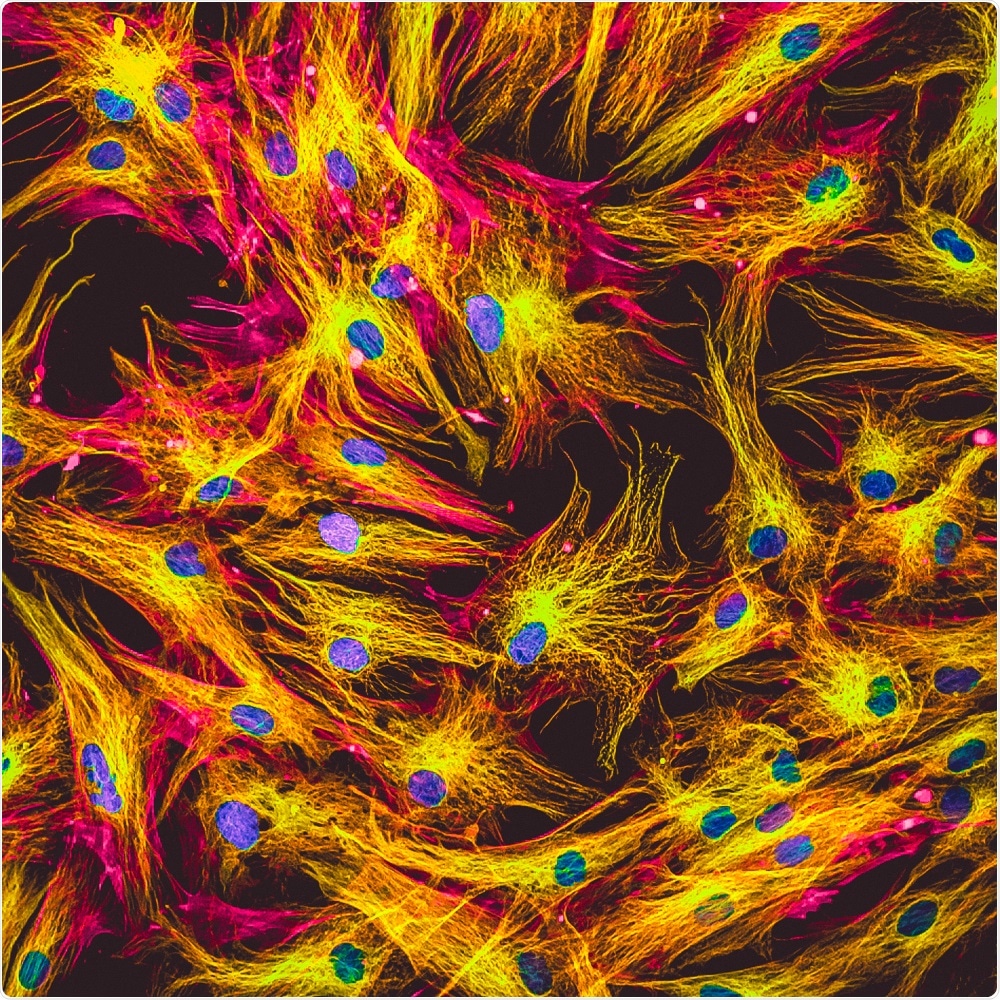A minute chemical modification on one of the most copious and vital proteins in cells—actin—has been a mystery as its function is not fully known.
However, researchers from the Perelman School of Medicine at the University of Pennsylvania have taken efforts toward solving the mystery.

Image Credit: Vshivkova/Shutterstock.com
The researchers described their findings on the post-translational modification of actin in Science Advances and believe that the discovery offers insights into the construction of life, which is similar to understanding the evolution of a star or a black hole.
This basic information can prospectively inform studies into a wide spectrum of diseases such as muscle weakness and immune deficiency syndromes due to defects or failure in actin. The study demonstrates the modification of actin and should expedite further studies on how actin works and is regulated in cells.
The researchers employed X-ray crystallography and other sophisticated methods to unravel the atomic-scale structure of actin when it is modified by a partner enzyme when a cluster of atoms, referred to as an acetyl group, attach at the commencement of the chain of amino acids that forms the protein.
The modification is known as N-terminal acetylation and can occur on a wide array of human proteins and is considered to have significant biological functions. But those functions have not been clearly understood in the case of actin.
The study outcomes also reveal the general biology of N-terminal acetylation. For the first time, the atomic-scale structure of any type of protein has been identified has been determined when it is modified in this way.
These are fundamental findings that extend our understanding of how actin works and also how N-terminal acetylation works.”
Roberto Dominguez, PhD, Study Senior Author and William Maul Measey Presidential Professor of Physiology, University of Pennsylvania School of Medicine
The significance of actin is highlighted by the fact that it is one of the most abundant proteins found in the cytoplasm— the space outside the nucleus—of mammalian cells.
Most prominently, it forms cable-like structures known as filaments, which constitute a major portion of the supportive “skeleton” of cells, and also play a vital role in the division of cells and their ability to move within tissues.
There is a possibility of N-terminal acetylation occurring on actin, as it occurs on over 80% of human proteins, and has been found to control actin’s ability to develop filaments. But the exact functions of this modification are still a mystery.
It was only in 2018 that a team led by Dominguez along with his colleagues at the University of Bergen in Norway led by Dr. Thomas Arnesen discovered the enzyme that catalyzes actin N-terminal acetylation.
The NAA80enzyme is one of seven enzymes that regulate N-terminal acetylation on human proteins; however, it is special as it works only on actin. In the latest study, Dominguez, Arnesen, and their teammates followed up their finding of NAA80 by investigating how it selectively acts only on actin among several other proteins in the cell.
One main discovery was that NAA80 was unable to recognize and acetylate actin upon assembling the protein into filaments. However, it acetylates actin when it occurs as a separate molecule, known as a monomer.
But the most potent N-terminal acetylation took place only when actin was bound to another protein named profilin—a known partner of actin that is closely associated with actin’s formation of filaments. Similar to actin, profilin is also highly abundant in cells.
It was a surprise to us to find that this protein, NAA80, appears to have evolved to recognize not actin alone but the profilin-actin complex. It suggests that profilin has a role as a ‘chaperone’ that allows actin to be N-terminally acetylated prior to filament formation.”
Roberto Dominguez, PhD, Study Senior Author and William Maul Measey Presidential Professor of Physiology, University of Pennsylvania School of Medicine
Using X-ray crystallography, the researchers constructed an atomic-scale image of this three-way actin-profilin NAA80 complex. They have been able to decipher the atomic structure of an N-acetyltransferase, for the first time, when it adds an acetyl group to another protein.
The achievement proved that the unique structure of NAA80 permits it to particularly recognize and acetylate all the six variants or “isoforms” of actin that exist in human cells—although the site on the protein where these actin variants vary is exactly the site that NAA80 acetylates.
The structural and functional features we uncovered in this study also explain how NAA80 performs N-terminal acetylation only on actin and not on other proteins.”
Roberto Dominguez, PhD, Study Senior Author and William Maul Measey Presidential Professor of Physiology, University of Pennsylvania School of Medicine
This research is a basic advance in cell biology. By typically developing a more comprehensive picture of actin’s functions and dynamics within cells, researchers can gain better insights into several disorders in which those functions and dynamics are interrupted. These include tissue development, muscle and heart function, and migration of numerous pathogens and cancer cells during metastasis.